A sourdough baguette is the perfect side to nearly any dinner. With a perfect crispy crust and chewy interior, you’ll love the savory tang of this classic French bread.
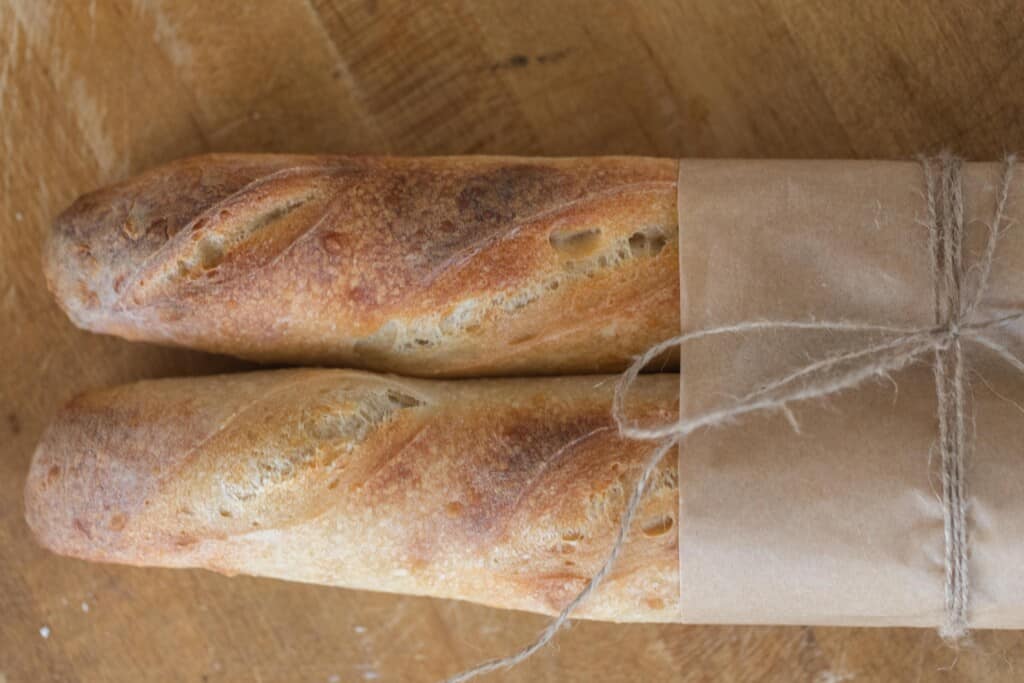
Artisan bread seems to elevate any simple dish into a restaurant experience. A homemade meal is made even more special when paired with homemade small batch bread such as sourdough brioche dinner rolls, sourdough French bread or sourdough garlic bread with rosemary.
These homemade sourdough baguettes are no exception. With this detailed sourdough baguette recipe, you can recreate this Italian classic in your own home oven. They are perfectly browned and have that craveable, crunchy crust and airy interior that baguettes are known for.
All you need is a little patience, time, and a handful of ingredients to be left with the perfect side to any pasta dish, or simply a delicious vessel for homemade herb butter.
Why You’ll Love This Recipe
Flavorful – Traditional baguettes are made with a few staple ingredients. Having the sourdough starter added gives this bread a bit more of that sourdough tang we all know and love! If you want even more flavor, these are perfect for pairing with this bread dipping oil recipe.
Nutritious – Since you are using sourdough, you get all the benefits of fermented grains. This means it is more easily digested and the nutrients are more available for your body to absorb.
Impressive – You’ll impress all of your dinner guests when you have a beautiful, homemade, golden crusted sourdough baguette on the dinner table.
Ingredients
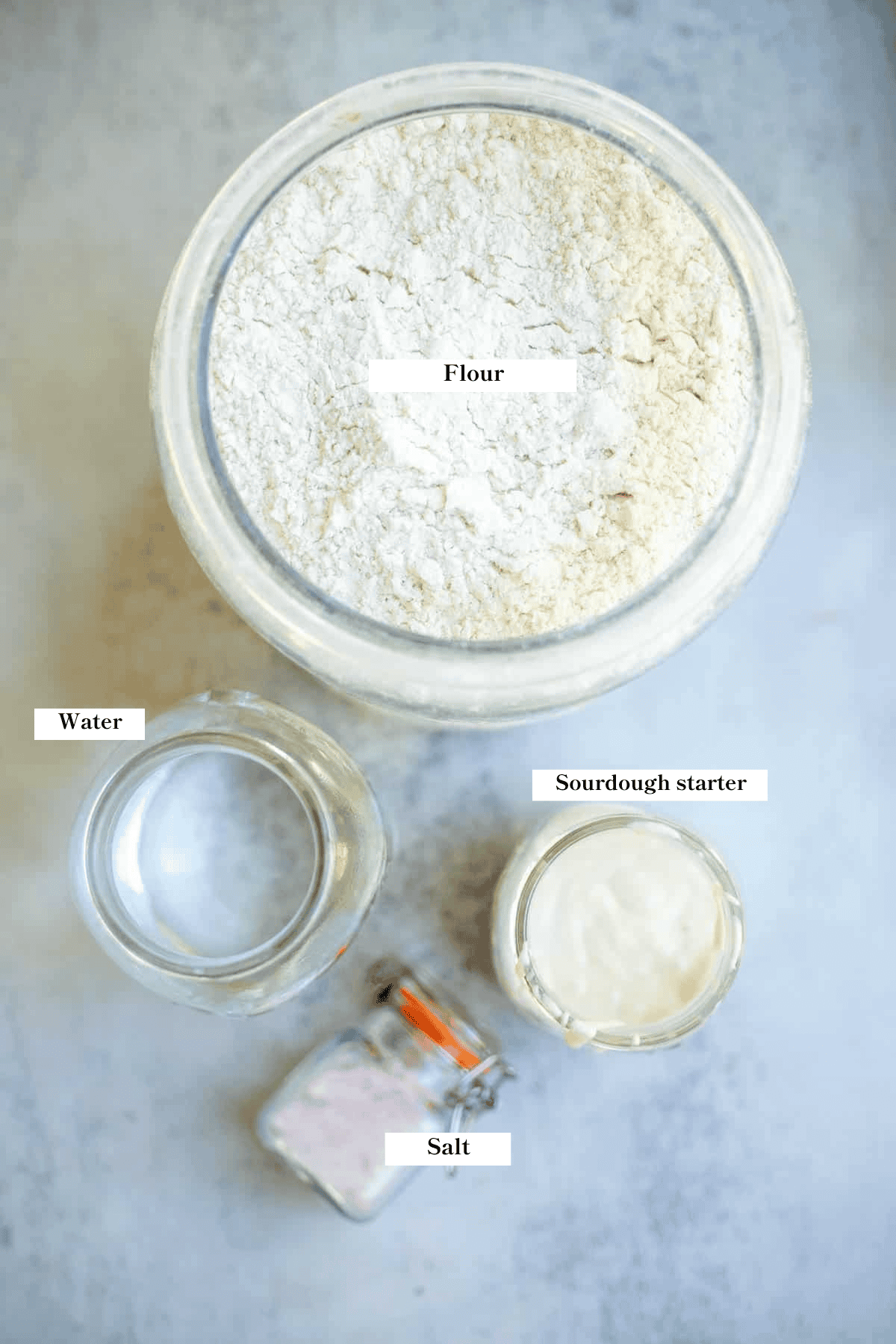
Water – Be sure to use filtered water, as regular tap water may affect your sourdough starter because of harmful additives like chlorine.
Active Sourdough Starter – Make sure it is active and bubbly! Feed starter about 4-12 hours before you plan on using it. This amount of time will depend on the temperature if your kitchen. Starters that have been stored in the fridge may take a bit longer to reach its peak activity before it is ideal to use. If you are new to sourdough you can check out this post to learn how to make a sourdough starter and this post to learn how to care for a sourdough starter.
A full ingredient list with exact amounts can be found in the recipe card below.
How to Make Sourdough Baguettes
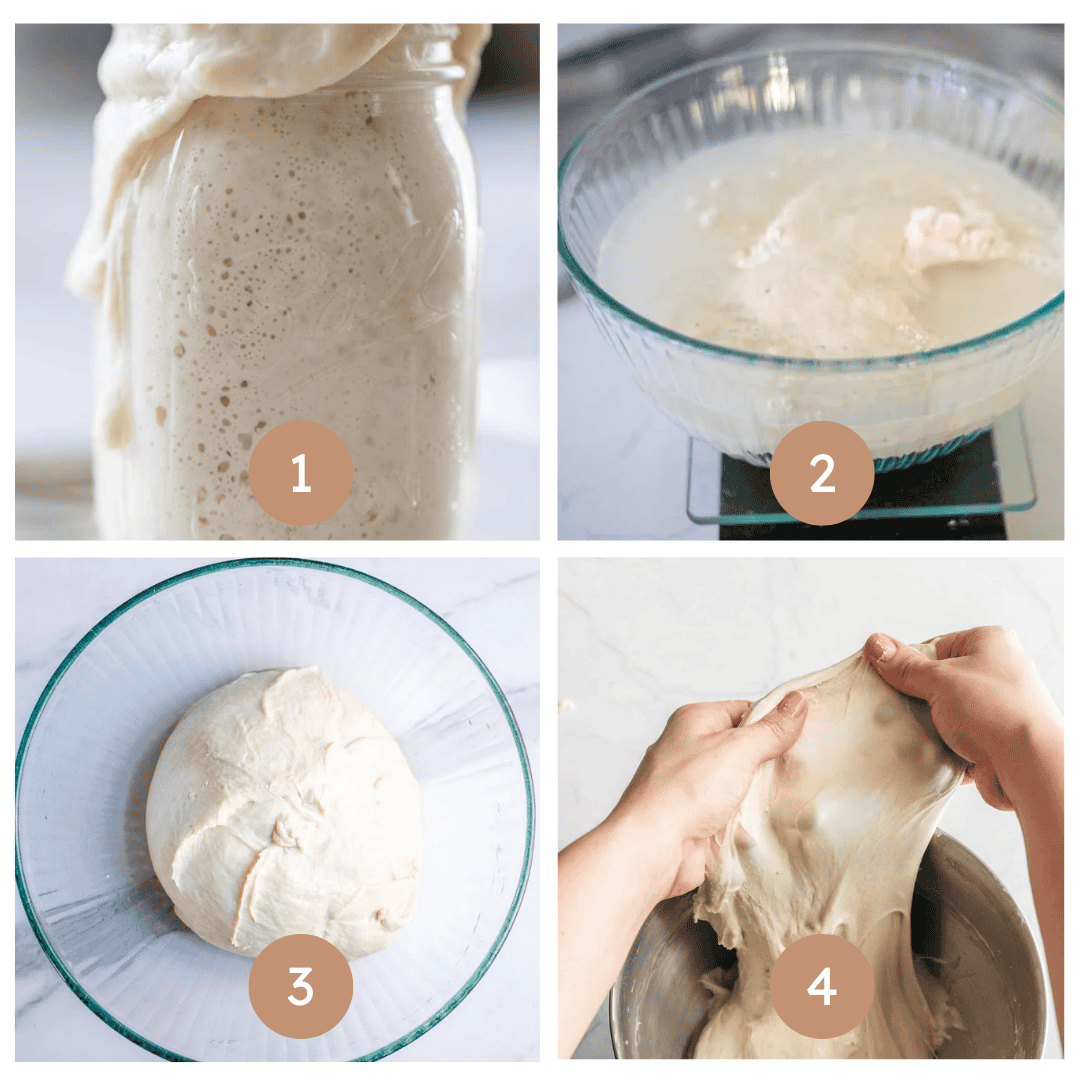
Step 1: Feed your sourdough starter 4-12 hours before starting the bread so it is active and bubbly once you begin. (Image 1)
Step 2: Combine your warm water and flour in a large bowl. You’ll want to let this mixture rest for 30 minutes for a process called autolyse. (Image 2)
Step 3: Using wet hands, dimple in your sourdough starter to the rested flour and water mixture. Sprinkle the salt on top. Mix the dough for about 5 minutes so the dough comes together. Cover the dough with plastic wrap or a damp towel and let the dough rest for 30 minutes. (Image 3)
Step 4: After the resting period, this dough will need 6 rounds of stretching and folding in order to develop the gluten and obtain a nice rise. With the dough in the bowl, grab the edge of the dough firmly and pull up – stretching it upwards. Then place the dough in your hands into the center. (Image 4)
Turn the bowl about a quarter turn and do this stretch and fold again. Repeat this process one to two more times. This is considered one stretch and fold round.
Repeat according to the directions below. If the dough is too sticky, you can dip your hand in water.
First 3 stretch and folds – every 15 minutes.
Last 3 stretch and folds – every 30 minutes.
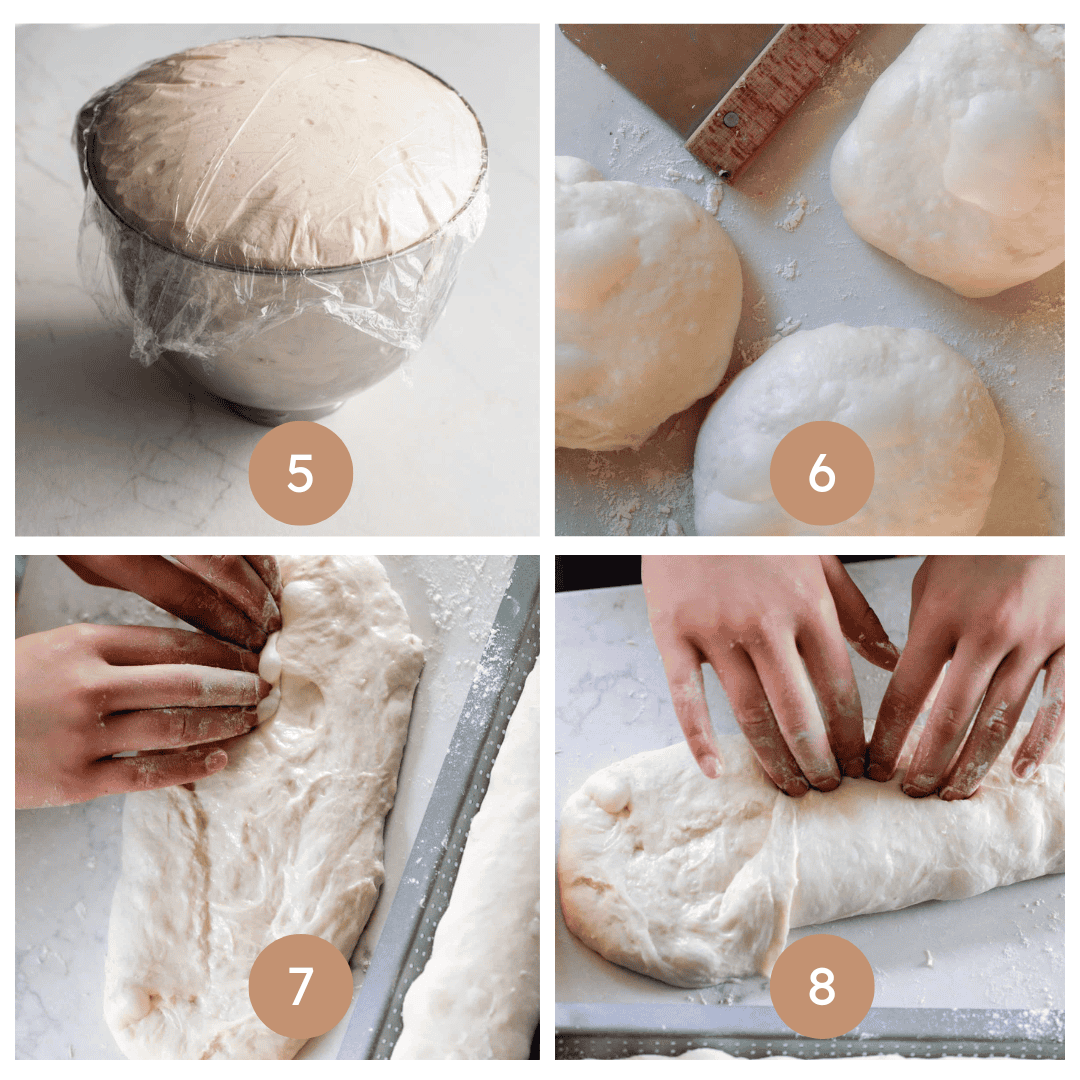
Step 5: When you are finished with the 6 rounds of stretch and folds, cover the dough with a wet towel or plastic wrap. Allow it to bulk-ferment at room temperature until it has doubled. (Image 5)
Step 6: On a clean work surface, divide the dough into three equal parts using a bench scraper. Pre-shape by providing slight tension and creating a ball with each piece of dough and allow to bench rest for about 20 minutes on the counter. (Image 6)
Step 7: For the final shape, shape the baguette dough by gently stretching the dough out into a rectangle about 10” long by 5” wide. Fold one long side into the middle and press your fingers into the seam all the way down it to seal it. Repeat with the other long edge, so that there is one seam in the middle where the two sides meet. (Image 7)
Step 8: Roll the dough over, so that it is seam side down, and gently create tension along the seam by pulling it against the counter. This will also elongate the shape as you continue to pull the dough. I like mine to be about 14” for a final length, so they can rest in my perforated baguette mold. Repeat for the other two pieces of dough. (Image 8)
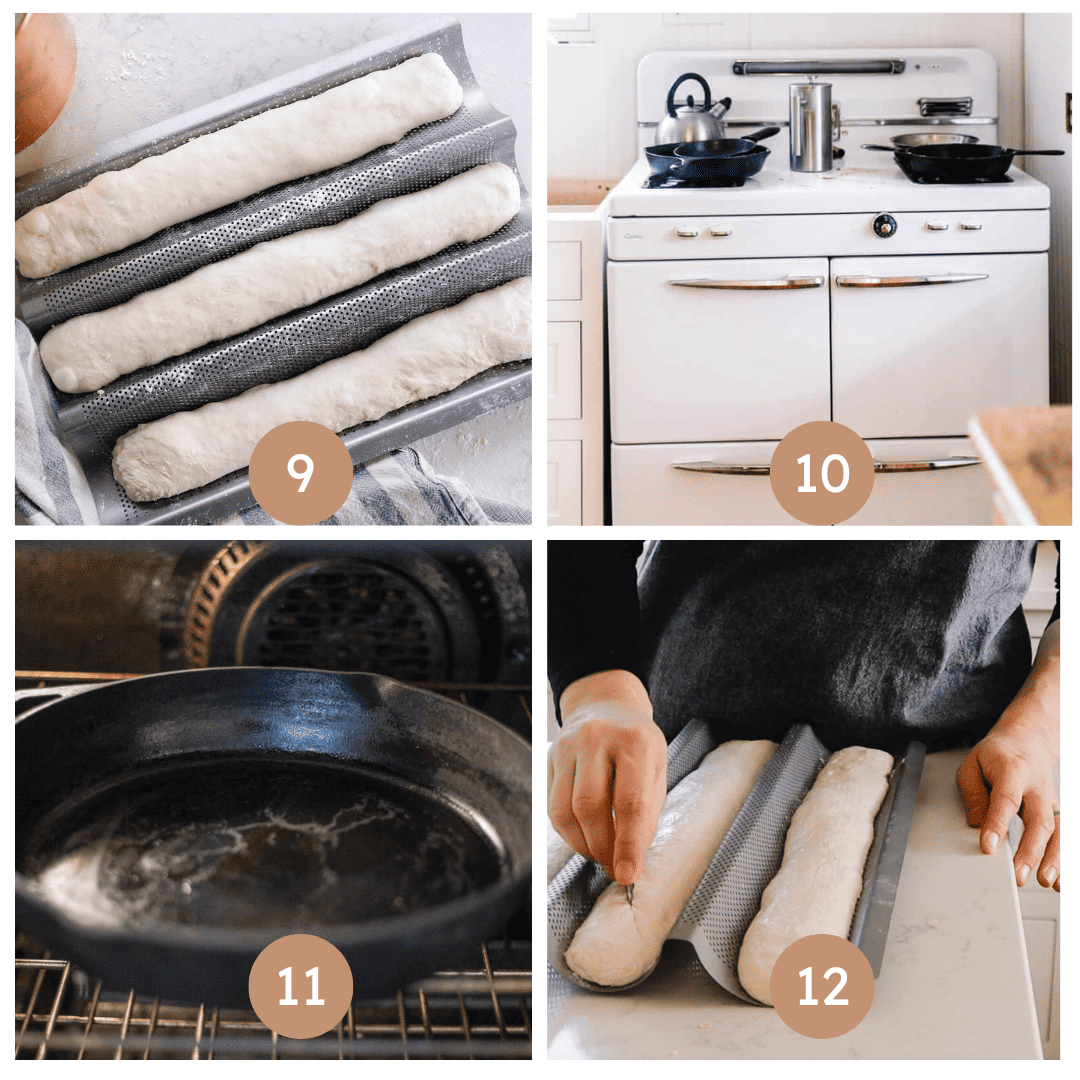
Step 9: Place your shaped baguettes in a baker’s couche or baguette tray or mold. A baker’s couche is a canvas cloth used to shape your baguettes. You could also make a DIY version using a tea or kitchen towel and a few clothes pins to help it keep its shape. If using a couche or cloth, you may want to place it all on a baking sheet so you can easily transport it. (Image 9)
Step 10: The next day, preheat a baking stone (optional) at 500 degrees for about an hour. Although I don’t actually bake directly on the pizza stone, I like to have it in there to keep the oven very hot when I put the cold baguettes in. This helps them to poof up, also known as oven spring. (Image 10)
Step 11: Get a pot or kettle of boiling water going. On the rack at the bottom of the oven, add a cast iron skillet. (Image 11)
Step 12: Remove the baguettes from the fridge. Score the top of the dough with a razor blade with 3 or 4 fairly deep scores cut at a 45 degree angle. (Image 12)
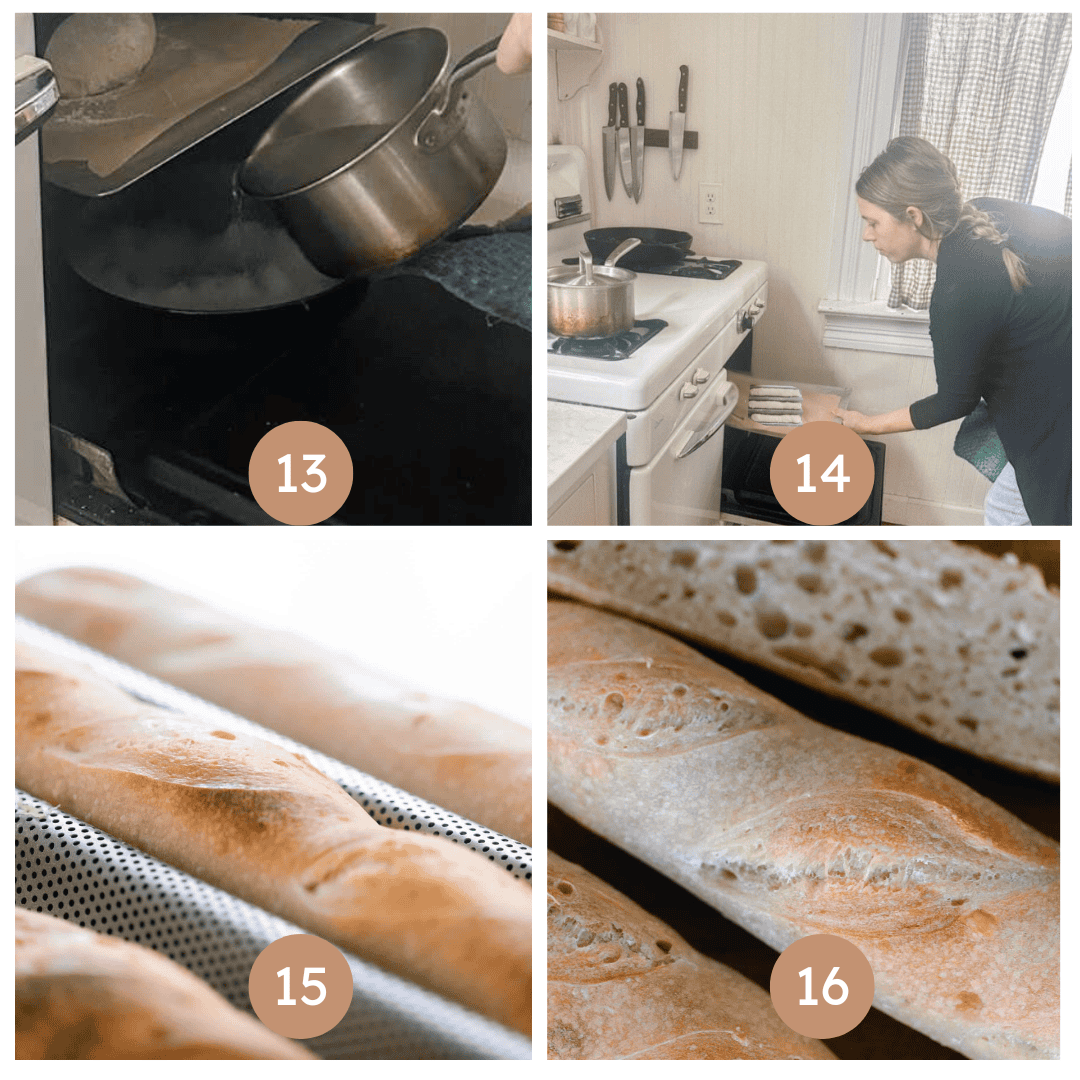
Step 13: Fill the cast iron skillet you placed in your oven with boiling water. (Image 13)
Step 14: Spritz the top of the baguettes with water for browning. (Image 14)
Step 15: Load the baguettes onto the stone. I leave mine in the perforated baguette pan, and place that on top of the stone. If you use a couche to shape your dough, remove the baguettes from the couche and place them directly on the stone. Do NOT put the couche in the oven. Carefully open the oven door, as you’ll likely have quite a bit of steam come out once opened. (Image 15)
Step 16: Reduce the heat to 450 degrees and bake for 35 minutes. In my oven, I achieve the best browning when I rotate the baguettes after about 20 minutes of baking. (Image 16)
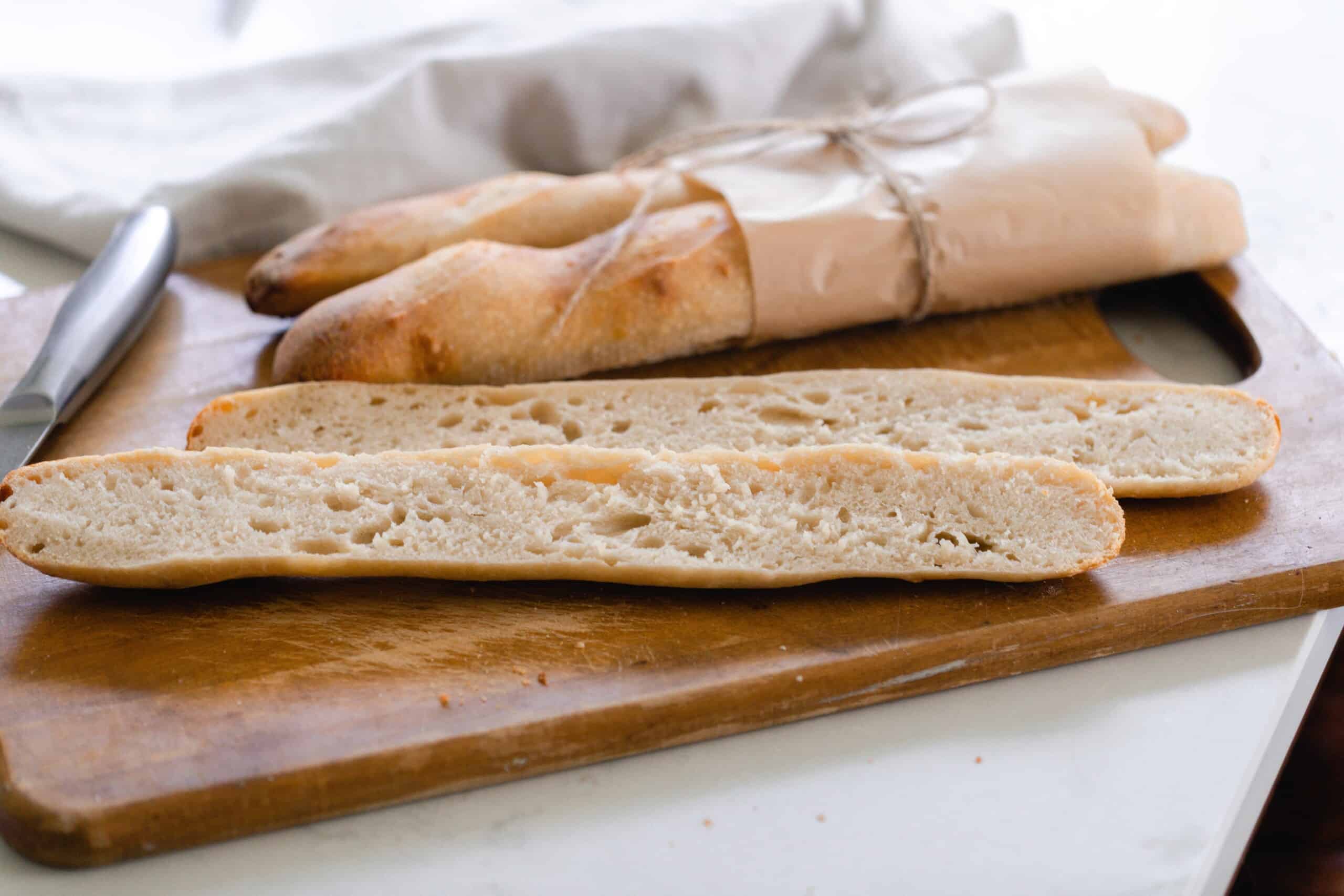
Tips
- The timing for bulk fermentation will vary greatly depending on many factors – temperature, hydration, maturity and strength of the starter, etc. If you’d like, you can let this step go longer for further health benefits. I typically do this in the morning and let it go all day. When the dough is ready, there will be small bubbles on the surface.
- During the rising process and bulk fermentation, make sure to cover the dough with a damp towel or plastic wrap to avoid any unpleasant crusts from forming.
- When placing the cast iron pan in your oven that you will use with water to create steam, try not to place it directly under your baking bread. Rather, place it off to the side slightly so that the steam can rise to the baguettes easier and create a crisp crust.
- Leftover stale baguettes make delicious homemade sourdough croutons.
Troubleshooting
There could be a couple of factors at play here, but the most likely culprit is lack of moisture in the oven. Adding the boiling water to your oven may seem like overkill, but it is essential in developing a crisp, golden crust.
The starches in your dough will eventually absorb the moisture from the oven. With the right amount, the baguette will form a starch-like gel on the outside. This eventually turns into your crunchy crust.
The right moisture level makes all the difference in a perfect baguette.
Dense bread without that airy crumb tends to indicate a lack of yeast activity, meaning your dough did not proof long enough. Don’t forget – the bulk ferment may take a lot longer depending on temperature and other environmental factors.
Recipe FAQs
Thanks to the fermented grains in sourdough, it is typically easier to digest. That also means it’s easier on your body to absorb the vitamins and minerals in the bread.
A baguette is a French bread that is known for its long, thin shape and golden crust.
Traditionally, French baguettes are made with yeast. However, using sourdough starter as your leavening agent adds a delicious, tangy flavor that really takes this bread over the top!
The only difference is your leavener. Sourdough uses a special starter made with flour and water, while a traditional French baguette is normally made with commercial yeast.
You’ll still get the same shape and crust, but you’ll also get a more robust flavor with sourdough.
We love to have a piece of sourdough baguette as a side to dinner. It can go with almost anything, but we especially love it with soup, like my Roasted Red Pepper And Tomato Soup, and even eggs!
Adding a little herb butter on a warm slice will take it over the top.
Baker’s Timeline:
This can be started or made at any time. I like to start doughs at night time so they can rise all night. In the morning, they are ready to shape, boil, and bake.
Feed sourdough starter with flour and water.
12 p.m. – Combine your warm water and flour. You’ll want to let this mixture rest for 30 minutes for a process called autolyse.
12:30 p.m. – Add sourdough starter and salt. Mix dough. Let rest for 30 minutes.
1 p.m. – Begin 6 rounds of stretches and folds according to the schedule above.
3 p.m. – Cover your dough with a wet towel or plastic wrap. Allow it to bulk-ferment until it has doubled.
8:30 p.m. (or sooner/later) – Shape your dough into 3 equal parts and shape into balls. Let rest for 20 minutes.
9 p.m. – Complete final shaping of dough and place it in a baguette mold or baker’s couche. Cover and refrigerate overnight or up to 36 hours.
9 a.m. the next morning – Prep your oven and baguettes and bake!
More Sourdough Recipes from the Farmhouse
- Homemade Sourdough Oatmeal Cream Pies
- Delicious Homemade Sourdough Pita Chips
- 100% Fresh Milled Sourdough Bread
- Sourdough Bundt Cake
- Whole Wheat Sourdough Dinner Rolls
If you try this recipe and love it, I would love it if you could come back and give it 5 stars! Tag me on Instagram @farmhouseonboone.
Sourdough Baguette Recipe

Equipment
- 1 Baguette pan or baker's couche
Ingredients
- 625 grams all purpose flour
- 450 grams water
- 100 grams sourdough starter
- 13 grams salt
Instructions
- Feed your sourdough starter 4-12 hours before starting the bread so it is active and bubbly once you begin.
- Combine your warm water and flour in a large bowl. You’ll want to let this mixture rest for 30 minutes for a process called autolyse.
- Using wet hands, dimple in your sourdough starter to the rested flour and water mixture. Sprinkle the salt on top. Mix the dough for about 5 minutes so the dough comes together. Cover the dough with plastic wrap or a damp towel and let the dough rest for 30 minutes.
- After the resting period, this dough will need 6 rounds of stretching and folding in order to develop the gluten and obtain a nice rise. With the dough in the bowl, grab the edge of the dough firmly and pull up – stretching it upwards. Then place the dough in your hands into the center.
- Turn the bowl about a quarter turn and do this stretch and fold again. Repeat this process one to two more times. This is considered one stretch and fold round.
- Repeat according to the directions below. If the dough is too sticky, you can dip your hand in water.
- First 3 stretch and folds – every 15 minutes.
- Last 3 stretch and folds – every 30 minutes.
- When you are finished with the 6 rounds of stretch and folds, cover the dough with a wet towel or plastic wrap. Allow it to bulk-ferment at room temperature until it has doubled.
- On a clean work surface, divide the dough into three equal parts using a bench scraper. Pre-shape by providing slight tension and creating a ball with each piece of dough and allow to bench rest for about 20 minutes on the counter.
- For the final shape, shape the baguette dough by gently stretching the dough out into a rectangle about 10” long by 5” wide. Fold one long side into the middle and press your fingers into the seam all the way down it to seal it. Repeat with the other long edge, so that there is one seam in the middle where the two sides meet.
- Roll the dough over, so that it is seam side down, and gently create tension along the seam by pulling it against the counter. This will also elongate the shape as you continue to pull the dough. I like mine to be about 14” for a final length, so they can rest in my perforated baguette mold. Repeat for the other two pieces of dough.
- Place your shaped baguettes in a baker’s couche or baguette tray or mold. A baker’s couche is a canvas cloth used to shape your baguettes. You could also make a DIY version using a tea or kitchen towel and a few clothes pins to help it keep its shape. If using a couche or cloth, you may want to place it all on a baking sheet so you can easily transport it.
- The next day, preheat a baking stone (optional) at 500 degrees for about an hour. Although I don’t actually bake directly on the pizza stone, I like to have it in there to keep the oven very hot when I put the cold baguettes in. This helps them to poof up, also known as oven spring.
- Get a pot or kettle of boiling water going. On the rack at the bottom of the oven, add a cast iron skillet.
- Remove the baguettes from the fridge. Score the top of the dough with a razor blade with 3 or 4 fairly deep scores cut at a 45 degree angle.
- Fill the cast iron skillet you placed in your oven with boiling water.
- Spritz the top of the baguettes with water for browning.
- Load the baguettes onto the stone. I leave mine in the perforated baguette pan, and place that on top of the stone. If you use a couche to shape your dough, remove the baguettes from the couche and place them directly on the stone. Do NOT put the couche in the oven. Carefully open the oven door, as you’ll likely have quite a bit of steam come out once opened.
- Reduce the heat to 450 degrees and bake for 35 minutes. In my oven, I achieve the best browning when I rotate the baguettes after about 20 minutes of baking.
Notes
- Please double check amounts when using the multiplying feature in the recipe card.
- Bulk fermentation times will vary greatly depending on many factors – temperature, hydration, maturity and strength of the starter, etc. If you’d like, you can let this step go longer for further health benefits. I typically do this in the morning and let it go all day. When the dough is ready, there will be small bubbles on the surface.
- During the rising process and bulk fermentation, make sure to cover the dough with a damp towel or plastic wrap to avoid any unpleasant crusts from forming.
- The boiling water creates steam in the oven, which gives you oven spring. Basically, you have two options. You can either make your whole oven steamy with boiling water and heat, or enclose the baking process in a long Dutch oven. Of course, baguettes are too long to fit in a regular sized Dutch oven, which is why I opt for the stone and steam method.
- When placing the cast iron pan in your oven that you will use with water to create steam, try not to place it directly under your baking bread. Rather, place it off to the side slightly so that the steam can rise to the baguettes easier and create a crisp crust.
- Leftover stale baguettes make delicious homemade sourdough croutons.
Nutrition
Nutrition information is automatically calculated, so should only be used as an approximation.












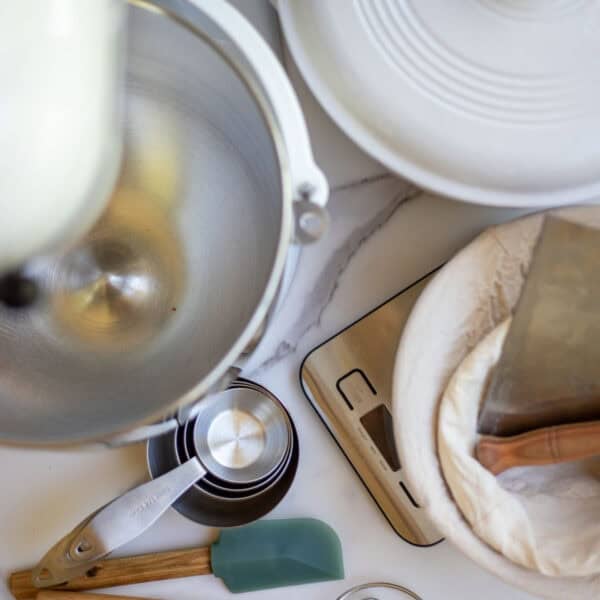







My dough was quite sticky and very difficult to work with. Can the hydration be reduced in this recipe?
Slightly. It does come together once you work with it a bit.
Can I skip the cold proofing in the fridge?
Yes!
Can you post your recipe in cups as well vs grams?
I have a conversion chart.
I make sourdough all the time, but not baguettes. These did not rise at all overnight in the fridge. They came out very dense. I think next time I will let them rise in a warm spot overnight, as I do with loaves.
The baguette pan you linked to on amazon says it has a maximum temperature of 425. Is that the one you actually use ?
Yes, I haven’t had a problem with it!
Thank you for the recipe, it’s very good.
I use a little pan ( Stainless steel ) that I bought in Michels. ( I think ) not to expensive like 14,00 $ and is for making a small
Lasagna. It takes up to 600 degrees Celsius and it is perfect to put on the bottom of the Oven. I use it when I bake bread,
On a Pizza Stone to produce steam in the Oven.
Just a little tip in case need something that takes lots o temperature.
Your Baguettes are really very good. btw I use Black Emmer Flour. From janiesmill.com. ( Ancients Flours )
Great family company and Organic products..
Thank you so much for your recipes
Best regards from Germany and Malden Massachusetts
I’m new to sourdough baking. Is it important to use all purpose vs baking flour? What would be the impact of this difference?
Do you mean bread flour? It really depends on the recipe on what type of flour is being called for. Bread flour does have more protein which can help make fluffier bread since the gluten strands are stronger.
This is sooo delicious and just like the baguettes you buy. I am so happy to have the added benefit of the sourdough! Thank you so much!
Thank you! Glad you enjoyed it!
These turned out perfect! Fluffy in the middle and crispy/chewy on the outside! Will definitely make again.
Glad you enjoyed the recipe! Have a great day!
I have a gas oven – same process of pan and water?
Yes. I have a gas stove as well.